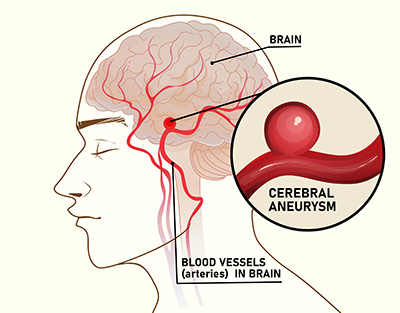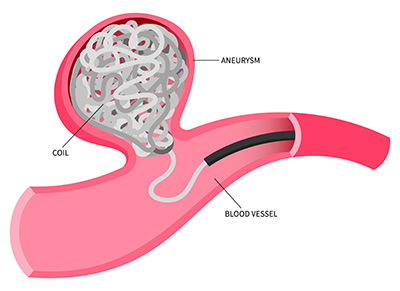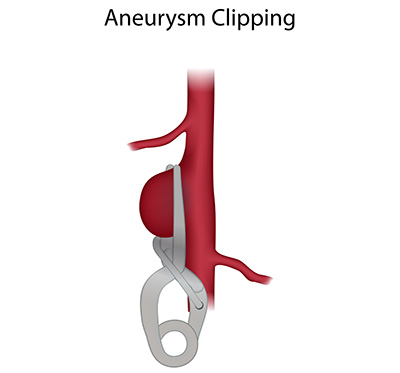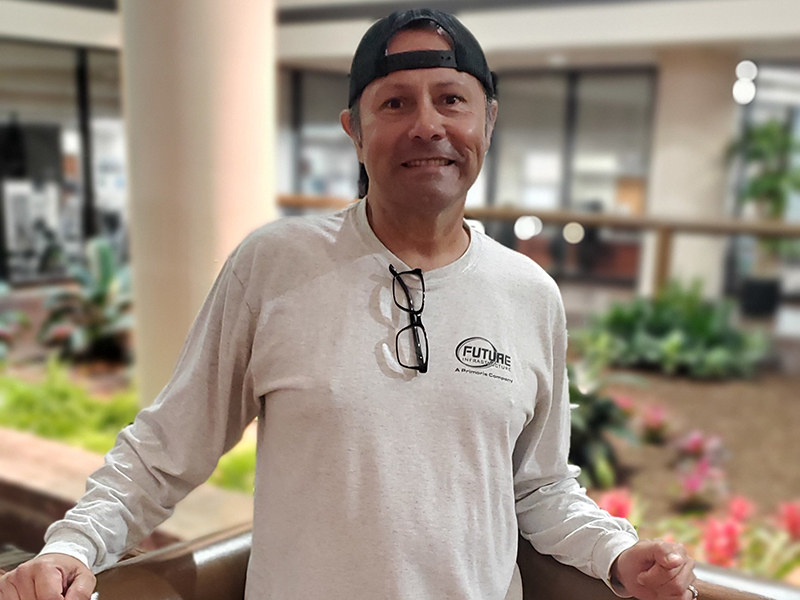A brain aneurysm is a weak, bulging spot in a blood vessel in the brain. Because the walls of the aneurysm are thin and fragile, there is a chance the aneurysm could burst — much like an overfilled balloon or a worn tire. Unlike a stroke event that happens when blood flow to the brain is interrupted, an aneurysm is a condition.
 If a brain aneurysm ruptures, it causes bleeding in the space around the brain. The bleeding can lead to a type of stroke called a subarachnoid hemorrhage (SAH). A SAH happens when blood flow is interrupted due to the bleeding between the skull and the brain. Severe brain damage or death may occur if the hemorrhage is not immediately addressed.
If a brain aneurysm ruptures, it causes bleeding in the space around the brain. The bleeding can lead to a type of stroke called a subarachnoid hemorrhage (SAH). A SAH happens when blood flow is interrupted due to the bleeding between the skull and the brain. Severe brain damage or death may occur if the hemorrhage is not immediately addressed.
The good news is that many brain aneurysms are treatable, so it is important to know the risk factors and warning signs.
Risk Factors for a Brain Aneurysm
- Smoking – Smoking can raise triglycerides, lower “good” cholesterol, and damage cells that line the blood vessels. It can also increase the buildup of plaque that causes thickening and narrowing of blood vessels.
- Hypertension – Over time, high blood pressure can weaken the walls of blood vessels, raising the chances of an aneurysm forming.
- Family history – If a parent, sibling, or other close family member has had a ruptured aneurysm, you may be at higher risk. This risk increases if multiple relatives have had brain aneurysms or ruptures.
- Age – While brain aneurysms can occur at any age, they are most common in adults ages 30-60. Disorders such as Ehlers-Danlos syndrome or Marfan syndrome in children may put them at higher risk.
- Gender – Women are more likely to have brain aneurysms than men, and their risk increases after menopause.
- Drug or excessive alcohol use – The use of hard drugs such as cocaine and amphetamines can cause blood vessels to swell and raise blood pressure, both of which increase the risk of an aneurysm. Alcohol can produce a similar effect.
- Traumatic head injury – A head injury can damage blood vessels or stretch their walls.
Warning Signs and Symptoms of a Ruptured Brain Aneurysm
- Sudden intense headache – A headache you would considered one of the “worst headaches of your life” may be a sign that an aneurysm has ruptured. This requires immediate medical attention.
- Blurred, sensitive, or double vision – Your vision may become blurry, or you may “see double” and become overly sensitive to light.
- Dilated pupils – One or both of your pupils may appear larger than normal.
- Difficulty speaking – Slurred speech or trouble finding the right words could be linked to an aneurysm or its rupture.
- Pain above and behind the eye – Any pain or weakness around your eye could be a result of an aneurysm pressing on nearby nerves.
- Numbness – You might feel weakness or numbness due to the aneurysm bursting or putting pressure on surrounding tissues and nerves.
Brain Aneurysm Treatment Options
Sometimes if a brain aneurysm is small and hasn’t ruptured or caused symptoms, it may be monitored by a neurologist or neurovascular surgeon on the medical staff at a Texas Health hospital with regular imaging tests to check for any changes. Lifestyle changes you implement, such as quitting smoking and weight loss for blood pressure control, can go a long way towards reducing the risk for aneurysm growth and rupture.
When observation alone is not enough, your doctor may recommend medication to treat for risk factors such as high blood pressure with the aim of further reducing the risk of an aneurysm rupturing.
-
Endovascular Coiling
 Endovascular coiling is currently the most common treatment for brain aneurysms. This minimally invasive procedure does not require general anesthesia or opening of the skull.
Endovascular coiling is currently the most common treatment for brain aneurysms. This minimally invasive procedure does not require general anesthesia or opening of the skull.A skilled neurosurgeon on the medical staff at a Texas Health hospital will accesses the aneurysm through a catheter inserted into an artery in the arm or groin. Small metal coils are then inserted into the aneurysm to block blood from flowing into the aneurysm.
Patients treated for unruptured brain aneurysms may go home within 24 hours. Patients with ruptured aneurysms remain in the hospital longer for monitoring.
-
Surgical Clipping
 Brain aneurysm surgery, commonly referred to as clipping, is necessary when an aneurysm cannot be coiled due to its location or other characteristics. Under general anesthesia, an incision is made, and the skull is opened to access the unruptured aneurysm or to repair the damage due to a rupture. Part of the preparation for this surgery may include shaving a section of the hair on your head. The neurosurgeon then places a small metal clip (about the size of a tiny clothespin) at the base of the aneurysm, stopping blood flow into the aneurysm.
Brain aneurysm surgery, commonly referred to as clipping, is necessary when an aneurysm cannot be coiled due to its location or other characteristics. Under general anesthesia, an incision is made, and the skull is opened to access the unruptured aneurysm or to repair the damage due to a rupture. Part of the preparation for this surgery may include shaving a section of the hair on your head. The neurosurgeon then places a small metal clip (about the size of a tiny clothespin) at the base of the aneurysm, stopping blood flow into the aneurysm.Patients treated for an unruptured brain aneurysm may leave the hospital within a few days, while patients treated for a ruptured aneurysm will usually leave the hospital within two weeks.
Learn more about stroke and neuroscience services at Texas Health.
Sources:
Brain Aneurysm Foundation
American Stroke Association


